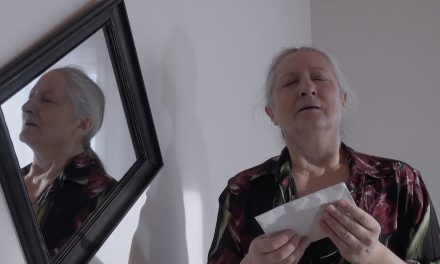Crying. Simphiwe Bonongo clings to a cross, shouting until the cries become more coherent. The shaky voice equilibrates to a sustained note. He’s singing to the beat of a snare drum. As the pitch rises, so do the arms of the dancers hiding in the shadows. The light christens their limbs.
This is the last time you’ll breathe in the entire show.
Vuyani Dance Theatre performed “Cion: Requiem of Ravel’s Boléro” by Gregory Maqoma at Royce Hall on September 21, 2024 to kick off the CAP UCLA season. Maqoma steered a tight ship with his choreography, blending African dance with contemporary and social dances — such as tap — to hone the strength of tension on stage. As the show progressed, there was no potential to estimate a step. Maqoma kept you on the edge of your seat, holding onto your breath only allowing the lungs to fill for a gasp — not because it was haunting, but because the movement was so free flowing.

Vuyani Dance Theatre in Cion: “Requiem of Ravel’s Bolér” by Gregory Maqoma – Photo by Jason Williams courtesy of CAP UCLA.
From death to rebirth, the performers embody the strife depicted in Zakes Mda’s novel of the same name. The South African writer’s tale follows Toloki who travels to Ohio and uncovers the history of the Underground Railroad. Maqoma’s choreography is not a direct translation of Mda’s work, but it pulls on the themes of ancestral connections and a yearning for something greater. Set in a graveyard filled with wooden crosses, the work by Maqoma uses percussion to traverse the tensions of post-Apartheid South Africa in well-defined choreographic chapters that each end in a challenging, heightened tempo.
The ensemble moves in unison like a well-oiled machine, embodying the music created by Bonongo, Xolisile Bongwana, Sbusiso Shozi and Fanizile Nzuza. The quartet of vocalists and musicians sing in tight harmonies based on Isicathamiya harmonies, layering atop each other to create swells and rhythms for the dancers to latch onto. As they sharply transition from soft vocals to quick phrases, the dancers fling their hands about like smoke rising off their skin. Every moment is precise.

Vuyani Dance Theatre in Cion: “Requiem of Ravel’s Bolér” by Gregory Maqoma – Photo by Jason Williams courtesy of CAP UCLA.
Although the ensemble works on a unified front, the choreography allows the performers to breathe and bring themselves to the stage. In one moment, the ensemble seems to lament the gravestones with crosses. On their feet, they lift their right leg behind them and move it to the front. Each dancer approaches the task differently. One keeps the leg extended while another has their leg bent down and another bends it in an attitude. After witnessing how strongly united the performers are, this moment cracks open the world built on stage to reveal the power of the individual.
Otto Nhlapo’s solo performance is particularly mesmerizing. He moves intentionally, isolating the movement up his spine and down his limbs. He holds onto the energy, allowing it to slow from joint to joint, before picking up speed to depict a moment of despair.

Vuyani Dance Theatre in Cion: “Requiem of Ravel’s Bolér” by Gregory Maqoma – Photo by Jason Williams courtesy of CAP UCLA.
Nhlapo is later joined by Roseline Wilkens for a section that speaks to the troubles of romance and motherhood while enslaved. Wilkens physicalizes the temptation of love when Nhlapo pulls her in. She giggles mid-sentence. The story goes on again until… a tug at the waist. She giggles. It becomes a game that keeps you wondering when the next disruption will occur. As the duo settles into the dynamic, it becomes clear that she is just as surprised as the audience. It’s a smart tactic that keeps the choreography fresh and exciting.
As Maqoma navigates the story from chapter to chapter, he takes control of the tension. Nhlapo slams a book closed and the ensemble falls to the ground. The rush of movement seems over. However, the musicians give everyone a rag which is then used to thwack against the ground. The dancers create a rhythm. Thwack — Thwack — Heave — Thwack. The tempo increases as they swing back and forth. It’s suffocating in the best possible way and then the story transitions. Maqoma is constantly challenging the tempo, all the way to the very end.

Vuyani Dance Theatre in Cion: “Requiem of Ravel’s Bolér” by Gregory Maqoma – Photo by Jason Williams courtesy of CAP UCLA.
The dancers step out in tap shoes and costumes designed by Black Coffee. They’re adorned in black lace with a cowboy hat atop their heads. They look dressed for a funeral, but it is the exact opposite. This is a rebirth. The dancers tap the same rhythm, slowly merging as one unit. The tempo grows faster and faster after each phrase. They tap to a tempo that feels humanly impossible. As an audience member, there’s no time to breathe. Until finally — clack.
The final tap. Seventy minutes later, you can breathe again.
For more information about Vuyani Dance Theatre, please visit their website.
For more information about Royce Hall, please visit their website.
To learn more about CAP UCLA, please visit their website.
Written by Steven Vargas for LA Dance Chronicle.
Featured image: Vuyani Dance Theatre in Cion: “Requiem of Ravel’s Bolér” by Gregory Maqoma – Photo by Jason Williams courtesy of CAP UCLA.







